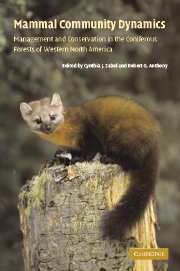 Mammal Community Dynamics
Mammal Community Dynamics Published online by Cambridge University Press: 15 December 2009
Conservation and management of mammals in western coniferous forest has been one of the important topics in ecology over the last two decades. The level of attention that such species as the grizzly bear, lynx, gray wolf, elk, and bison have attracted, plus the time and funds that have been expended on behalf of their management, exemplifies this interest. Listings of various species as threatened or endangered under the Endangered Species Act (ESA), particularly grizzly bears and gray wolves, has stimulated much research, initiated management activities, and prompted many political and legal decisions concerning the management of mammalian species. During this time period, however, a paradigm shift has changed emphasis from single-species conservation to conservation strategies for communities and ecosystems. This paradigm shift and the many legal challenges to federal agency management and policy decisions have resulted in the development of several ecosystem-level management plans, including the Northwest Forest Plan, the Interior Columbia River Basin Ecosystem Management Project, the Tongass National Forest Management Plan, the Sierra Nevada Ecosystem Project, and the Southern California Forest-Urban Interface Plan (Johnson et al. 1999). As a result of these research and conservation activities, increased information on mammalian communities, as well as interest in their management, has become available.
The geographic focus of this book is from the east side of the Rocky Mountains to the Pacific Ocean and from the southern United States to northern Canada and Alaska.
To save this book to your Kindle, first ensure [email protected] is added to your Approved Personal Document E-mail List under your Personal Document Settings on the Manage Your Content and Devices page of your Amazon account. Then enter the ‘name’ part of your Kindle email address below. Find out more about saving to your Kindle.
Note you can select to save to either the @free.kindle.com or @kindle.com variations. ‘@free.kindle.com’ emails are free but can only be saved to your device when it is connected to wi-fi. ‘@kindle.com’ emails can be delivered even when you are not connected to wi-fi, but note that service fees apply.
Find out more about the Kindle Personal Document Service.
To save content items to your account, please confirm that you agree to abide by our usage policies. If this is the first time you use this feature, you will be asked to authorise Cambridge Core to connect with your account. Find out more about saving content to Dropbox.
To save content items to your account, please confirm that you agree to abide by our usage policies. If this is the first time you use this feature, you will be asked to authorise Cambridge Core to connect with your account. Find out more about saving content to Google Drive.